Study on Inelastic Strain-Based Seismic Fragility Analysis for Nuclear Metal Components
Abstract
:1. Introduction
2. Procedures of Seismic FA for Nuclear Metal Components
2.1. Definitions of Failure Modes
2.2. Load Definition at Component Supports
- Case 1: when the site-specific ground response spectrum (GRS) is available.
- Case 2: when using the uniform response spectrum (URS) in NUREG/CR-0098 [24].
- Case 3: when only design floor response spectrum is available.
- Case 4: when floor response time histories are available.
2.2.1. For Case 1
2.2.2. For Case 2
2.2.3. For Case 3
- Develop or obtain the floor response spectra for the subsystem support locations at which time histories are required;
- If a single time histories are to be generated for multiple support locations, develop spectra that envelope all spectra at these locations;
- Modify the floor response spectra in accordance with ASCE 4–16 Section 6.2.3 [25] to account for uncertainties associated with supporting soil and structures and their analysis; and
- Generate the synthetic floor response time histories in accordance with the requirements of ASCE 4–16 Chapter 2.
2.2.4. For Case 4
2.3. Median Seismic Demand Calculation
2.4. Allowable Strain Capacity Calculation
2.5. Median Seismic Capacity
2.6. Variables of Logarithmic Standard Deviation
2.7. Calculation of HCLPF
3. Examples of Application
3.1. Description of Example Problem
3.2. Calculation of Median Seismic Demand as a Reference
3.3. Calculation of Allowable Strain Capacity
3.4. Determination of the Median Seismic Capacity as Reference Case
3.5. Definition of the Variables of Logarithmic Standard Deviation
3.5.1. Variables for Ground Motion
3.5.2. Variables for Structural Building Response
3.5.3. Variables for Component Response
3.6. Calculation of HCLPF
4. Conclusions
- Determination of median input motions for component seismic fragility analysis
- Material parameter identifications for inelastic material model
- Sensitivity studies on inelastic seismic responses with finite element models
- Detailed investigations for the variable definitions of ground motions, building structures, and components,
- Determination of logarithmic standard deviation value corresponding to the variables.
Author Contributions
Funding
Institutional Review Board Statement
Informed Consent Statement
Acknowledgments
Conflicts of Interest
References
- ASME BPVC Section III Appendices. Nonmandatory Appendix EE: Strain-Based Acceptance Criteria Definitions and Background Information; ASME: New York, NY, USA, 2019. [Google Scholar]
- ASME BPVC Section III Appendices. Nonmandatory Appendix FF: Strain-Based Acceptance Criteria for Energy-Limited Events; ASME: New York, NY, USA, 2019. [Google Scholar]
- ASME B&PV Code Committee. Alternative Rules for Level D Service Limits of Class 1, 2, and 3 Piping Systems; Section III, Division 1, ASME Code Case(Record No. 13–1438); ASME: New York, NY, USA, 2019. [Google Scholar]
- Masaki, M.; Akihiro, O.; Tomoyoshi, W.; Izumi, N.; Tadahiro, S.; Masaki, S. Seismic Qualification of Piping Systems by Detailed Inelastic Response Analysis: Part 1–A Code Case for Piping Seismic Evaluation Based on Detailed Inelastic Response Analyses. In Proceedings of the ASME 2017 PVP Conference, Waikoloa, HI, USA, 16–20 July 2017. [Google Scholar]
- Srinivasan, R.; Selman, P.B. Design Basis vs. Beyond Design Basis Considerations for Operating Plants. Transactions. In Proceedings of the SMiRT-23 Conference, Manchester, UK, 10–14 August 2015. [Google Scholar]
- ASME BPVC Section III Appendices. Mandatory Appendix XXVII: Design by Analysis for Service Level D; ASME: New York, NY, USA, 2019. [Google Scholar]
- Zhao, C.; Yu, N.; Oz, Y.; Wang, J.; Mo, Y.L. Seismic fragility analysis of nuclear power plant structure under far-field ground motions. Eng. Struct. 2020, 219, 110890. [Google Scholar] [CrossRef]
- Kim, S.W.; Jeon, B.G.; Hahm, D.G.; Kim, M.K. Seismic fragility evaluation of the base-isolated nuclear power plant piping system using the failure criterion based on stress-strain. Nucl. Eng. Technol. 2019, 51, 561–572. [Google Scholar] [CrossRef]
- Wang, Z.; Pedroni, N.; Zentner, I.; Zio, E. Seismic fragility analysis with artificial neural networks: Application to nuclear power plant equipment. Eng. Struct. 2018, 162, 213–225. [Google Scholar] [CrossRef] [Green Version]
- Park, J.; Towashiraporn, P.; Craig, J.I.; Goodno, B.J. Seismic fragility analysis of low-rise unreinforced masonry structures. Eng. Struct. 2009, 31, 125–137. [Google Scholar] [CrossRef]
- Tolentino, D.; Marquez-Dominguez, S.; Gaxiola-Camacho, J.R. Fragility Assessment of Bridges Considering Cumulative Damage Caused by Seismic Loading. Eng. Struct. 2020, 24, 551–560. [Google Scholar] [CrossRef]
- Xu, J. Guidance on Probabilistic-Risk-Assessment-Based Seismic Margin Assessments for New Reactors. Transactions. In Proceedings of the SMiRT-21 Conference, New Delhi, India, 6–9 November 2011. [Google Scholar]
- Electric Power Research Institute. Seismic Probabilistic Risk Assessment Implementation Guideline; Report 3002000709; Electric Power Research Institute (EPRI): Palo Alto, CA, USA, 2013. [Google Scholar]
- American Society of Civil Engineers. Seismic Analysis of Safety-Related Nuclear Structures; ASCE/SEI Standard 4–16; ASCE: Reston, VA, USA, 2017. [Google Scholar]
- Electric Power Research Institute. Methodology for Developing Seismic Fragility; EPRI/TR-103959; Electric Power Research Institute (EPRI): Palo Alto, CA, USA, 1994. [Google Scholar]
- ASME. Companion Guide to ASME Boiler Pressure Vessel Code; ASME: New York, NY, USA, 2009. [Google Scholar]
- Koo, G.H.; Kim, J.S.; Kim, Y.J. Feasibility Study on Strain-Based Seismic Design Criteria for Nuclear Components. Energies 2020, 13, 4435. [Google Scholar] [CrossRef]
- Electric Power Research Institute. Seismic Fragility Application Guide; EPRI/TR-1002988; Electric Power Research Institute (EPRI): Palo Alto, CA, USA, 2002. [Google Scholar]
- Barone, G.; Iacono, F.L.; Navarra, G.; Palmeri, A. Closed-form stochastic response of linear building structures to spectrum-consistent seismic excitations. Soil Dyn. Earthq. Eng. 2019, 125, 105724. [Google Scholar] [CrossRef]
- Barone, G.; Iacono, F.L.; Navarra, G.; Palmeri, A. A novel analytical model of power spectral density function coherent with earthquake response spectra. In Proceedings of the 1st International Conference on Uncertainty Quantification in Computational Sciences and Engineering (UNCECOMP), Crete Island, Greece, 25–27 May 2015. [Google Scholar]
- Muscolino, G.; Genovese, F.; Biondi, G.; Cascone, E. Generation of fully non-stationary random processes consistent with target seismic accelerograms. Soil Dyn. Earthq. Eng. 2021, 141, 106467. [Google Scholar] [CrossRef]
- Zhang, R.; Zhang, L.; Pan, C.; Chen, Q.; Wang, Y. Generating high spectral consistent endurance time excitations by a modified time-domain spectral matching method. Soil Dyn. Earthq. Eng. 2021, 145, 106708. [Google Scholar] [CrossRef]
- Nuclear Regulatory Commission. Design Response Spectra for Seismic Design of Nuclear Power Plants; Regulatory Guide 1.60; Nuclear Regulatory Commission: Rockville, MD, USA, 1973.
- Nuclear Regulatory Commission. Development of Criteria for Seismic Review of Selected Nuclear Power Plants; NUREG/CR-0098; Nuclear Regulatory Commission: Rockville, MD, USA, 1978.
- ASCE. Seismic Analysis of Safety-Related Nuclear Structures, ASCE Standard; ASCE/SEI 4–16; ASCE: Reston, VA, USA, 2017. [Google Scholar]
- Nuclear Regulatory Commission. Development of Floor Design Response Spectra for Seismic Design of Floor-Supported Equipment or Components; Regulatory Guide 1.122; Nuclear Regulatory Commission: Rockville, MD, USA, 1978.
- Nuclear Regulatory Commission. Damping Values for Seismic Design of Nuclear Power Plants; Regulatory Guide 1.61; Nuclear Regulatory Commission: Rockville, MD, USA, 2007.
- Newmark, N.M. Inelastic Design of Nuclear Reactor Structures and Its Implications on Design of Critical Equipment. Transactions. In Proceedings of the SMiRT-4 Conference, San Francisco, CA, USA, 15–19 August 1977. [Google Scholar]
- Riddell, R.; Newmark, N.M. Statistical Analysis of the Response of Nonlinear Systems Subjected to Earthquakes; SRS-468; Department of Civil Engineering, University of Illinois: Champaign, IL, USA, 1979. [Google Scholar]
- ANSYS. ANSYS Mechanical APDL Release 15.0; ANSYS, Inc.: Canonsburg, PA, USA, 2014. [Google Scholar]
- ASME BPVC Section III, Division 1. Subsection NB: Class 1 Components; ASME: New York, NY, USA, 2019. [Google Scholar]
- ASME BPVC Section III Appendices. Mandatory Appendix I: Design Fatigue Curve; ASME: New York, NY, USA, 2019. [Google Scholar]
- Electric Power Research Institute. A Methodology for Assessment of Nuclear Power Plant Seismic Margin (Revision 1); EPRI/NP-6041-SL; Electric Power Research Institute (EPRI): Palo Alto, CA, USA, 1991. [Google Scholar]
- Kennedy, R.P.; Ravindra, M.K. Seismic Fragilities for Nuclear Power Plant Risk Studies. Nucl. Eng. Des. 1984, 79, 47–68. [Google Scholar] [CrossRef]
- Argyroudis, S.A.; Fotopoulou, S.; Karafagka, S.; Pitilakis, K.; Selva, J.; Salzano, E.; Basco, A.; Crowley, H.; et al. A risk-based multi-level stress test methodology: application to six critical non-nuclear infrastructures in Europe. Nat. Hazards 2020, 100, 595–633. [Google Scholar] [CrossRef]
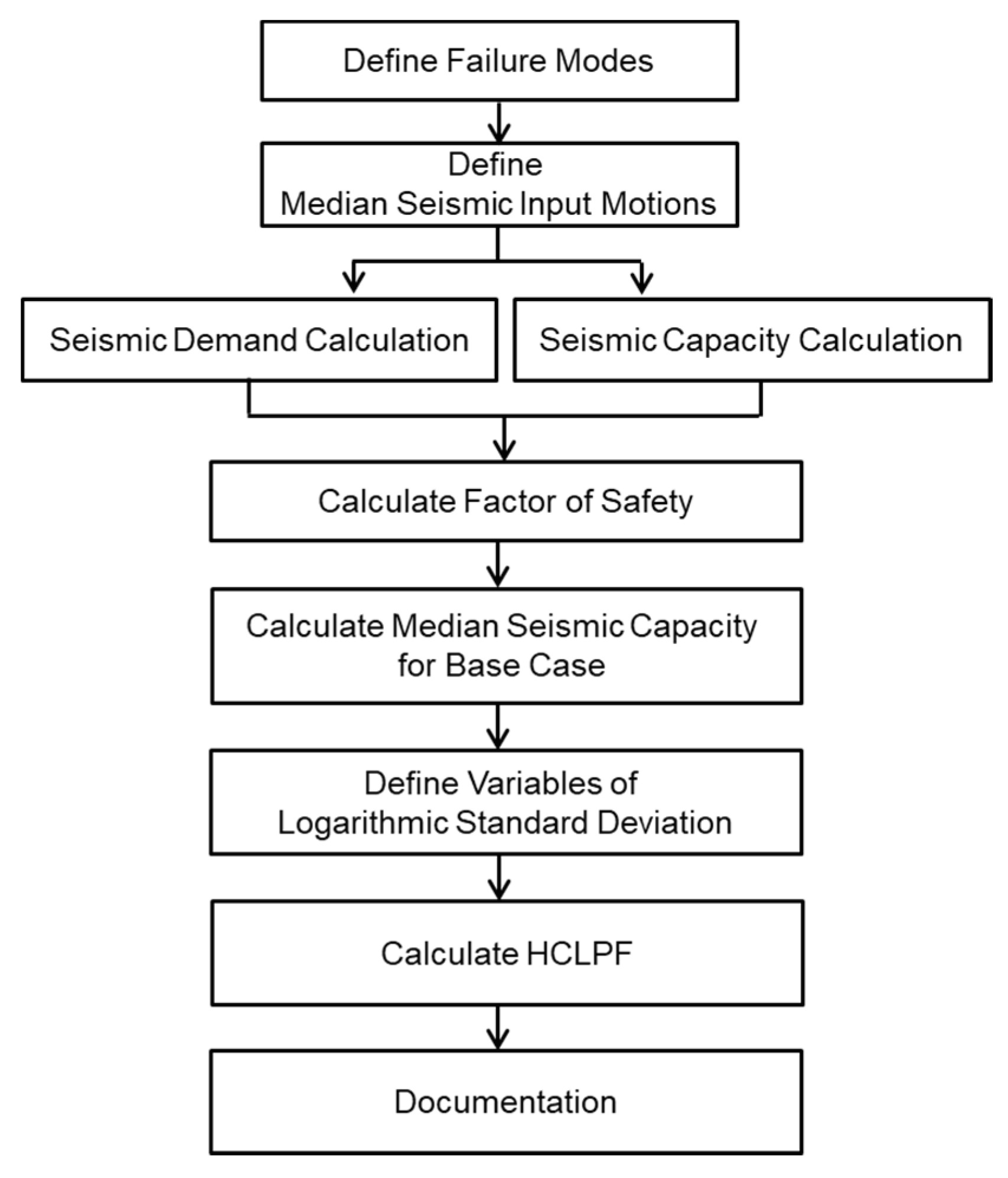

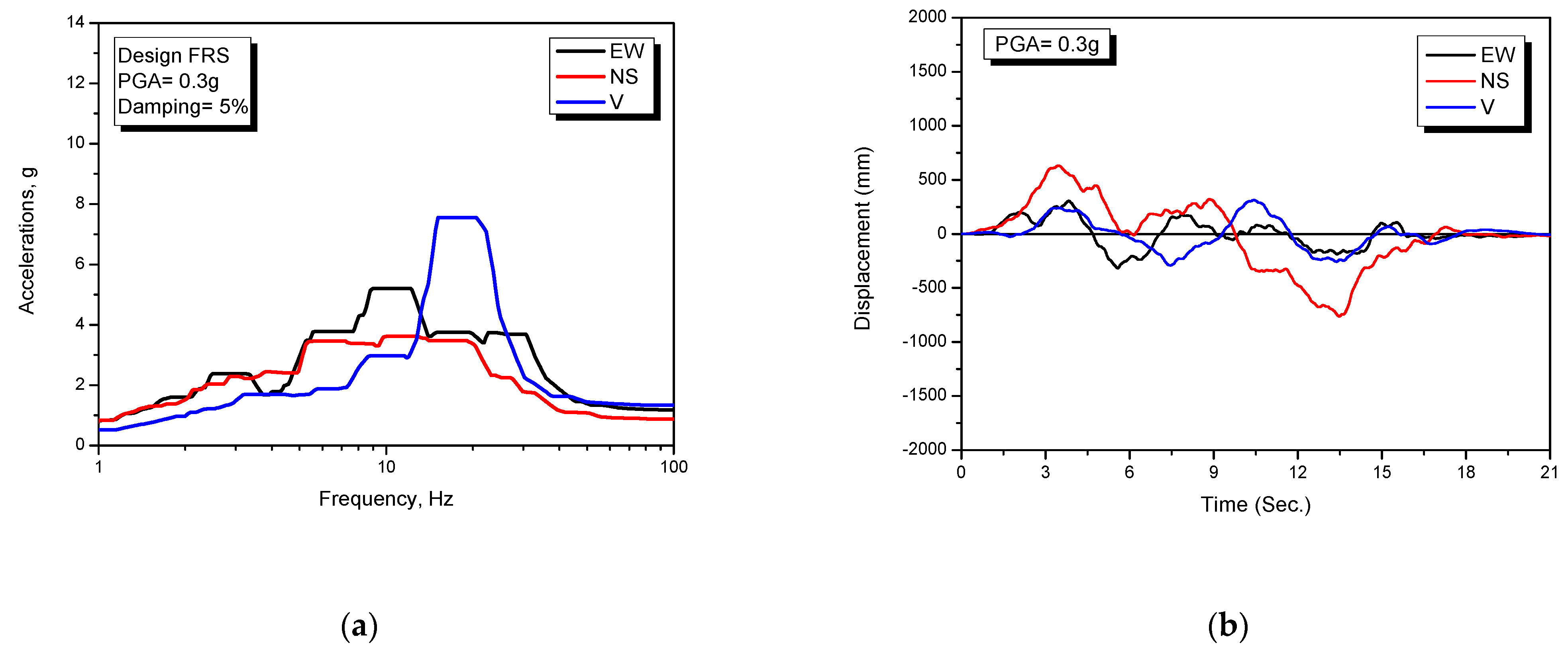

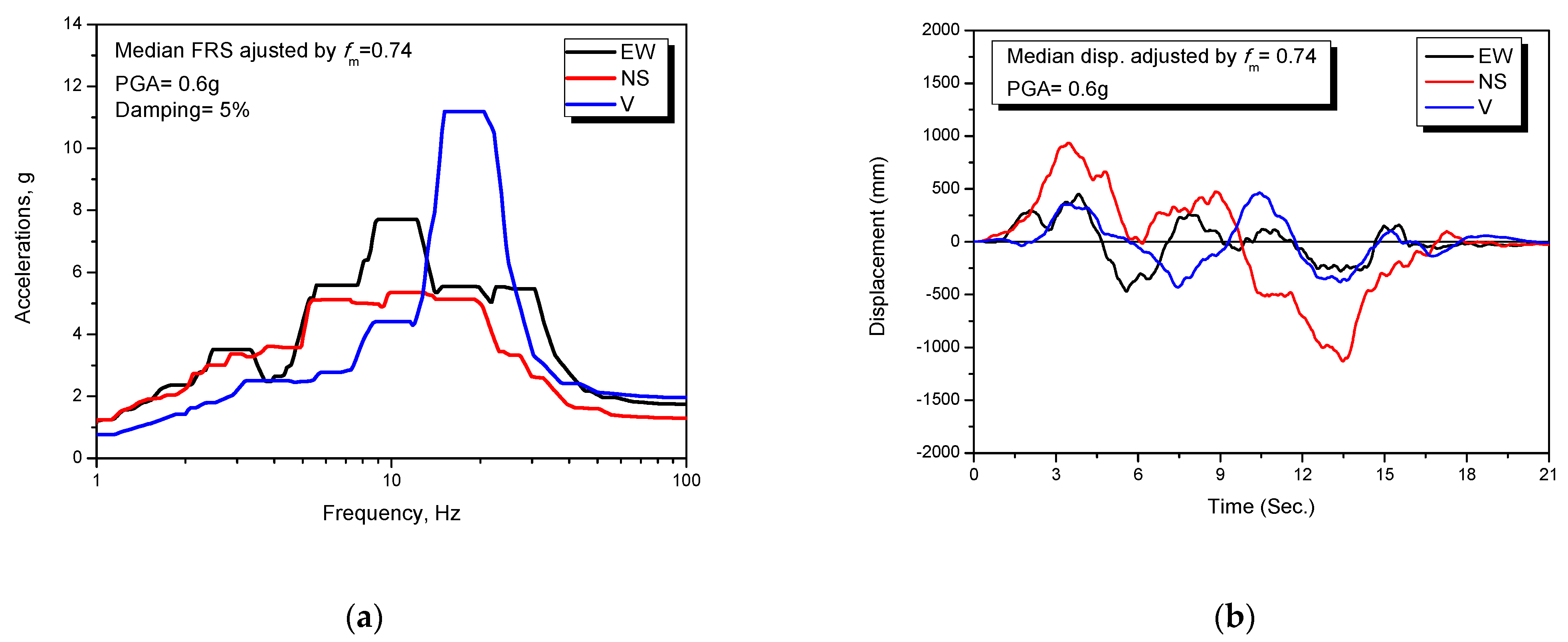
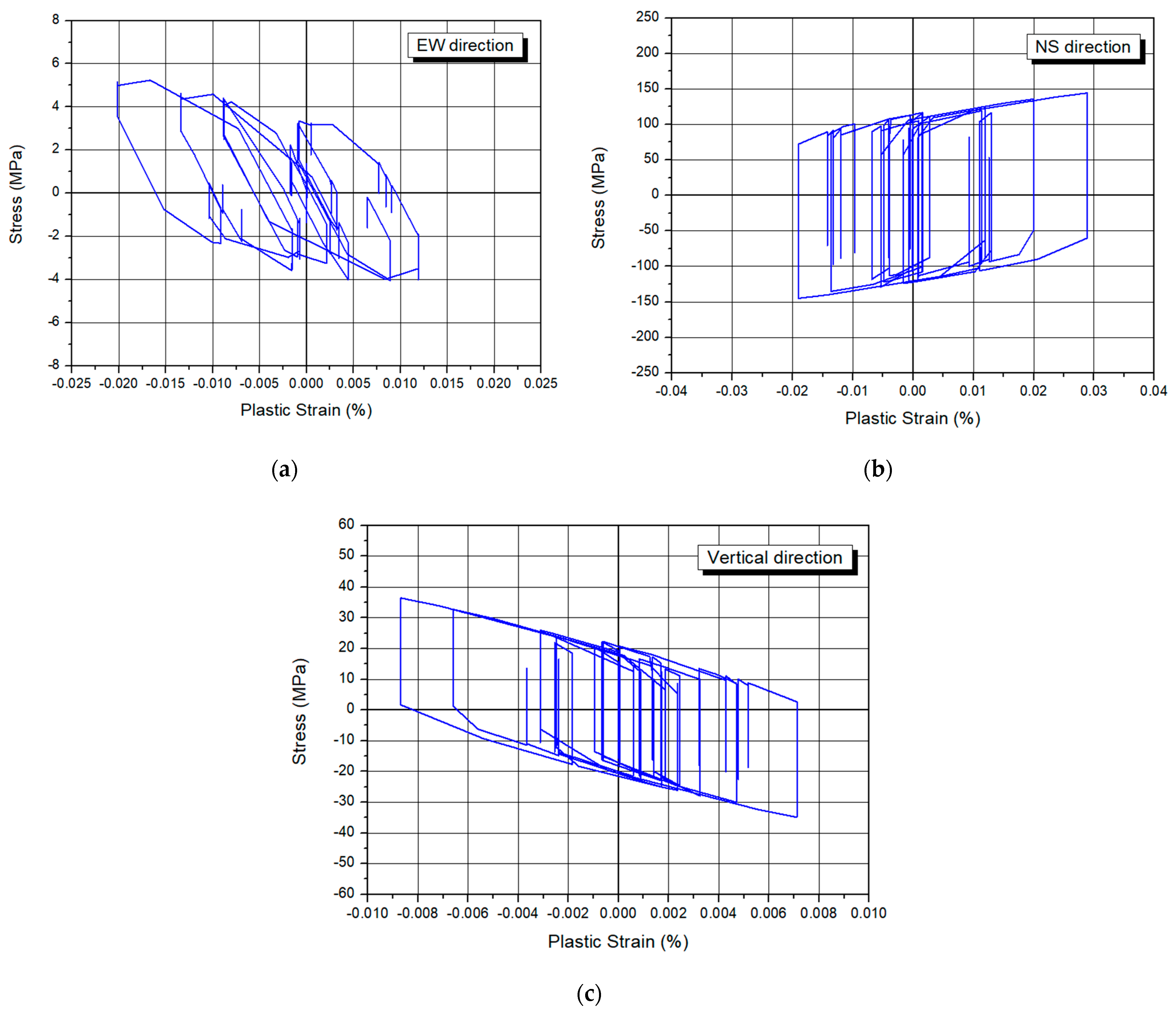


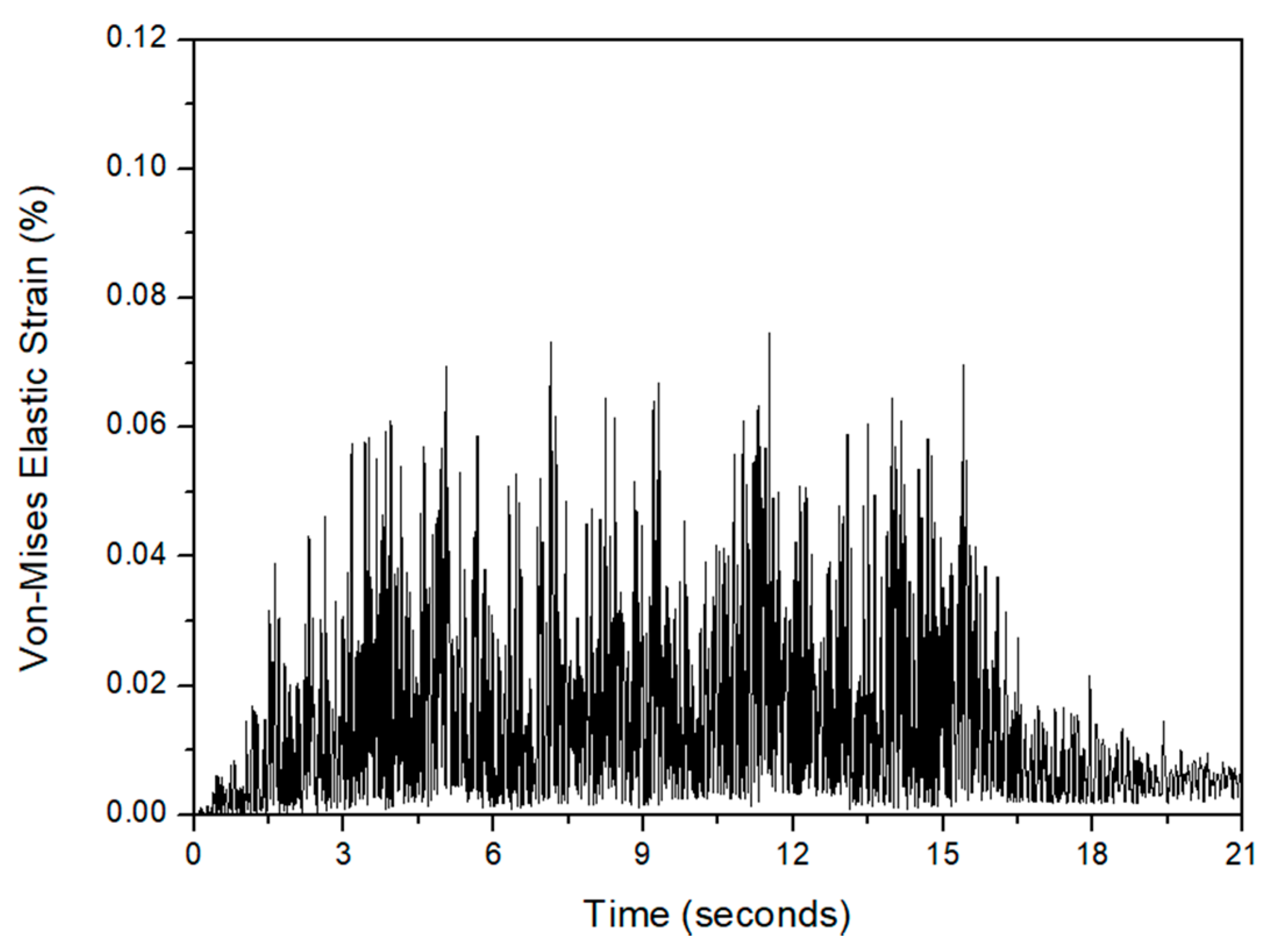
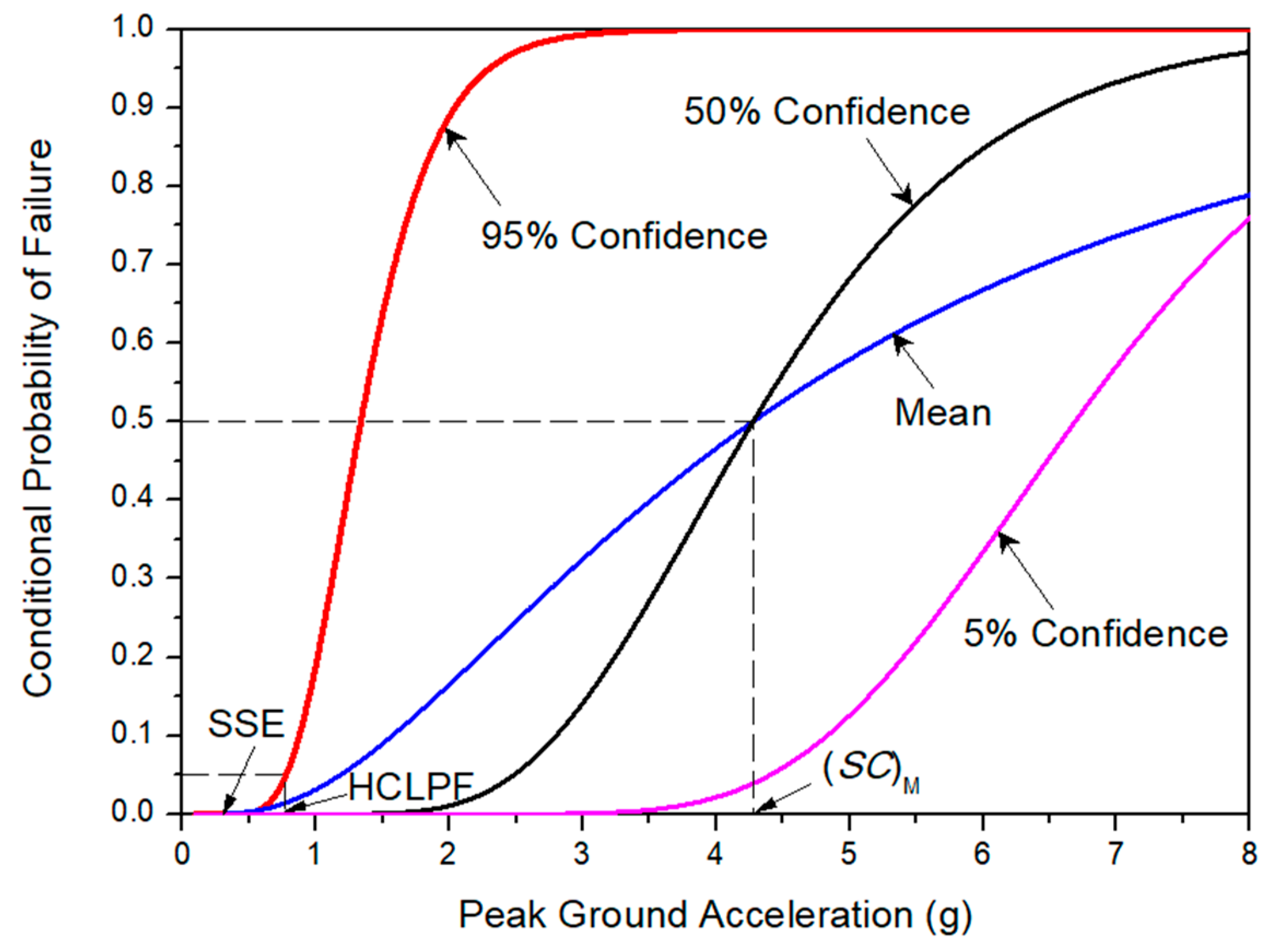
| Variables | Logarithmic Standard Deviation | |
|---|---|---|
| βR | βU | |
| For Ground Motion: | ||
| Earthquake Response Spectrum Shape (FERSS) | 0.20 | 0.20 |
| Horizontal Direction Peak Response (FHDPR) | 0.12 | - |
| Vertical Component Response (FVCR) | 0.10 | - |
| For Structural Building Response: | ||
| Damping (FSD) | - | 0.11 |
| Modeling (FSM) | - | 0.07 |
| Frequency (FSF) | - | - |
| For Component Response: | ||
| Damping (FCD) | - | D0.9f1: −1σ |
| Modeling (FCM) | - | 0.07 |
| Modal Combination (FCMC) | - | - |
| Variables | [TF(t)]avg | DM2 | CM2 | |||
|---|---|---|---|---|---|---|
| For reference | 0.102 | 0.033 | 0.260 | 1.421 | 0.514 | 2.933 |
| FERSS | 0.107 | 0.033 | 0.419 | 1.433 | 0.754 | 2.932 |
| FHDPR | 0.104 | 0.033 | 0.337 | 1.427 | 0.630 | 2.933 |
| FVCR | 0.105 | 0.033 | 0.365 | 1.384 | 0.651 | 2.934 |
| FSD | 0.108 | 0.033 | 0.483 | 1.325 | 0.783 | 2.936 |
| FSM | 0.106 | 0.033 | 0.393 | 1.375 | 0.685 | 2.934 |
| FCD | 0.104 | 0.033 | 0.300 | 1.440 | 0.582 | 2.932 |
| FCM | 0.106 | 0.033 | 0.393 | 1.375 | 0.685 | 2.934 |
| Variables | Variable Evaluated at 1σ | Adjusted Factor of Safety (FS)1σ | Logarithmic Standard Deviation | |
|---|---|---|---|---|
| βR | βU | |||
| For Reference Case | 5.703 | |||
| For Ground Motion: | ||||
| Earthquake Response Spectrum Shape (FERSS) | (ATH)EW e0.2 (ATH)NS e0.2 | 3.890 | 0.382 | 0.382 |
| Horizontal Direction Peak Response (FHDPR) | (ATH)EW e0.12 (ATH)NS e0.12 | 4.423 | 0.232 | - |
| Vertical Component Response (FVCR) | (ATH)V e0.1 | 4.509 | 0.235 | - |
| For Structural Building Response: | ||||
| Damping (FSD) | (ATH)EW e0.11 (ATH)NS e0.11 (ATH)V e0.11 | 3.751 | - | 0.419 |
| Modeling (FSM) | (ATH)EW e0.07 (ATH)NS e0.07 (ATH)V e0.07 | 4.283 | - | 0.286 |
| Frequency (FSF) | - | - | - | - |
| For Component Response: | ||||
| Damping (FCD) | D0.9f1:−1σ | 5.040 | - | 0.124 |
| Modeling (FCM) | (ATH)EW e0.07 (ATH)NS e0.07 (ATH)V e0.07 | 4.283 | - | 0.286 |
| Modal Combination (FCMC) | - | - | - | - |
| Check Lists | Results | |
|---|---|---|
| PGA for a reference | 0.6 g | |
| Factor of Safety, (FS)ref | 5.703 | |
| Median Capacity, (SC)M | 4.277 g | |
| LSD for randomness, βR | 0.330 | |
| LSD for uncertainty, βU | 0.707 | |
| HCLPF = (SC)M e−1.65(βR + βU) | 0.772 g | |
Publisher’s Note: MDPI stays neutral with regard to jurisdictional claims in published maps and institutional affiliations. |
© 2021 by the authors. Licensee MDPI, Basel, Switzerland. This article is an open access article distributed under the terms and conditions of the Creative Commons Attribution (CC BY) license (https://creativecommons.org/licenses/by/4.0/).
Share and Cite
Koo, G.-H.; Kwag, S.; Nam, H.-S. Study on Inelastic Strain-Based Seismic Fragility Analysis for Nuclear Metal Components. Energies 2021, 14, 3269. https://doi.org/10.3390/en14113269
Koo G-H, Kwag S, Nam H-S. Study on Inelastic Strain-Based Seismic Fragility Analysis for Nuclear Metal Components. Energies. 2021; 14(11):3269. https://doi.org/10.3390/en14113269
Chicago/Turabian StyleKoo, Gyeong-Hoi, Shinyoung Kwag, and Hyun-Suk Nam. 2021. "Study on Inelastic Strain-Based Seismic Fragility Analysis for Nuclear Metal Components" Energies 14, no. 11: 3269. https://doi.org/10.3390/en14113269






